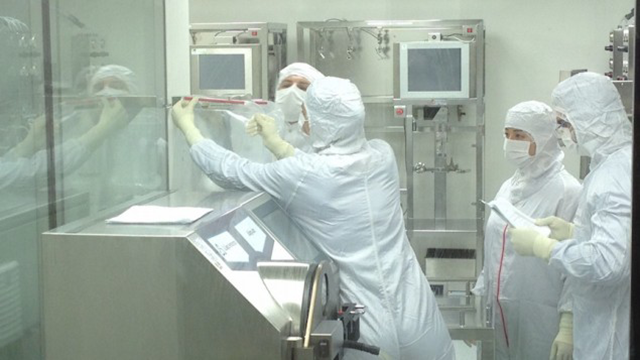Israeli biotech company Pluristem says its PLX technology could potentially treat and repair damaged nerves

Pluristem workers process placenta for the company's cell-based therapy products
A new study shows that placental cells could potentially treat and repair damaged nerves, leading the way to new treatment for stroke patients.
The findings indicate that PLacental eXpanded (PLX) cells, produced by Israeli biotech start-up Pluristem, protect PC12 cells – rat-derived cells that behave similarly to and are used as stand-ins to study human nerve cells.
The study also shows PLX cells protecting the PC12 cells from death after oxygen and glucose deprivation. Such deprivation is an important factor in stroke, thus indicating, according to Pluristem CEO Zami Aberman, that there is a good chance that PLX cells could prevent, or even reverse, the damage caused by stroke or other neuronal disease.
The ability to reverse stroke damage is just another of the unique properties of human placental cells, which research indicates is much more effective in dealing with many conditions than the regular stem cells that therapies currently rely on.
According to the research, the placenta contains mesenchymal-like adherent stromal cells, which have been found by researchers to have significant therapeutic potential. The cells promote tissue repair, possibly by secreting biologically active substances, including cytokines, that modulate immune response, along with factors that enhance the growth of blood vessels. These cells stimulate the body’s own mechanisms to heal damaged tissues.
“Usually, you need a genetic match, or at least tissue compatibility, in order to use cells for therapeutic purposes,” Aberman said. “But placenta is the only place in nature where an outside organism – a fetus – is able to co-exist with the body without triggering a reaction,” like the release of antibodies.”
The PC12 cell study reveals yet another property of placental cells – the ability to repair and restore nerve cells. The protective effects of PLX cells were strongly correlated with the secretion of interleukin 6 (IL-6) and vascular endothelial growth factor (VEGF), which scientists know protect nerves in humans who have sustained injuries to the nervous system that can occur after a stroke or similar events. A correlation, of course, is not necessarily a cause, but it’s an indication that there is a connection, scientists believe.
The current study was conducted jointly by researchers at Pluristem and Prof. Philip Lazarovici, Jacob Gitlin Chair in Physiology and Pharmacology at the School of Pharmacy Institute for Drug Research at the Hebrew University, and co-authored by Prof. Ephraim Yavin of the Department of Neurobiology at the Weizmann Institute of Science.
The study was supported by the Magnet program of Israel’s Ministry of Economy. It will be published in the February 2015 issue of Biochimica et Biophysica Acta Molecular Cell Research.
Pluristem “harvests” the placenta from a hospital in northern Israel, where it is donated by women undergoing caesarean section births. The births are planned in advance, allowing the company to set up the equipment needed to ensure that the placenta is still living and not contaminated by the environment. It is then rushed to Pluristem’s facility, where it is processed into PLX cells, for use in a variety of applications.
The company has conducted dozens of tests showing the efficacy of its solution, including several on animals that showed a very significant improvement in cases of radiation disease.
According to one of the studies, mice showed a four-fold increase in their survival rate, accompanied by a corresponding weight regain, and a large increase in blood cell count, when treated with Pluristem PLX cells. Other tests have shown how injuries to limbs repair themselves much faster, even among individuals with severe injuries, arteriosclerosis, and other conditions.
“These latest findings also call to mind two earlier preclinical studies,” said Aberman, “which indicated that PLX cells may be an effective treatment for both neuropathic and inflammatory nerve pain, suggesting that PLX cells could be a potential treatment for chronic nerve pain resulting from conditions such as diabetic neuropathy.”
